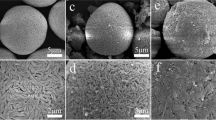Abstract
By introducing nickel chemical into the precursor sol of LiFePO4, a series of Ni-doped LiFePO4 composite cathode materials, denoted as LiFe1 − x Ni x PO4/C (x = 0, 0.01, 0.03, 0.05 and 0.10) were prepared by a spray drying–carbothermal approach. The materials were characterized with X-ray diffraction (XRD), scanning electron microscope (SEM), and electrochemical impedance spectrum etc. It is found that the doping of nickel with appropriate amount caused a slight shift of diffraction peaks towards higher angles and enhanced the dispersion of nanoprimary particles, which could be observed from their XRD patterns and SEM images. For the sample with 3 mol% Ni doing, the charge transfer resistance reduced from 52.4 Ω of LiFePO4 to 18.7 Ω of LiFe0.97Ni0.3PO4/C, and the potential interval of the redox peaks reduced from 0.51 to 0.40 V, indicating the better reversible of Ni-doped materials. For the sample LiFe0.97Ni0.03PO4/C, its initial discharge capacities at various rates are 169.2 (0.2 C), 156.2 (1.0 C), 147.9 (2.0 C), 135.5 (5.0 C), and 94.0 (10.0 C) mAh g−1, respectively, enhanced by 55.2 % (at 5.0 C) and 82.1 % (at 10.0 C) compared with LiFePO4. Furthermore, after 200 cycles of charge/discharge at 0.5 C, the capacity of LiFe0.97Ni0.03PO4/C only decreased 8.8 %, but over 25 % decrease was observed for LiFePO4/C.





Similar content being viewed by others
References
Padhi AK, Nanjundaswamy KS, Goodenough JB (1997) J Electrochem Soc 144(4):1188–1194
Tarascon JM, Armand M (2001) Nature 414:359–367
Jugovic D, Uskokovic D (2009) J Power Sources 190(2):538–544
Li H, Wang ZX, Chen LQ, Huang XJ (2009) Adv Mater 21(45):4593–4607
Fergus JW (2010) J Power Sources 195(4):939–954
Wang Y, He P, Zhou H (2011) Energy Environ Sci 4(3):805–817
Yuan L-X, Wang Z-H, Zhang W-X et al (2011) Energy Environ Sci 4(2):269–284
Liu WL, Tu JP, Qiao YQ et al (2011) J Power Sources 196:7728–7735
Zhou Y, Gu CD, Zhou JP et al (2011) Electrochim Acta 56:5054–5059
Chung SY, Bloking JT, Chiang YM (2002) Nat Mater 1(2):123–128
Wang GX, Bewlay SL, Konstantinov K et al (2004) Electrochim Acta 50(2–3):443–447
Liu H, Cao Q, Fu LJ et al (2006) Electrochem Commun 8(10):1553–1557
Bakenov Z, Taniguchi I (2010) J Electrochem Soc 157(4):A430–A436
Wang DY, Li H, Shi SQ et al (2005) Electrochim Acta 50(14):2955–2958
Ge Y, Yan X, Liu J et al (2010) Electrochim Acta 55:5886–5890
Zhang S, Deng C, Fu BL et al (2010) Electrochim Acta 55:8482–8489
Lu F, Zhou YC, Liu J et al (2011) Electrochim Acta 56:8833–8838
Zhang WK, Hu YL, Tao XY et al (2010) J Phys Chem Solids 71(9):1196–1200
Gao HY, Jiao LF, Peng WX et al (2011) Electrochim Acta 56:9961–9967
Bilecka, Hintennach A, Rossell MD et al (2011) J Mater Chem 21:5881
Wang ZH, Yuan LX, Wu M et al (2011) Electrochim Acta 56:8477–8483
Liu QB, Liao SJ, Song HY et al (2012) J Power Sources 211(8):52–58
Liu QB, Liao SJ, Song HY et al (2012) Curr Nanosci 8(2):208–214
Ren Q, Yang Y (2011) Chinese J Struct Chem 30(10):1477–1482
Zhang DY, Zhang PX, Yi JA et al (2011) J Alloy Compd 509(4):1206–1210
Yin XG, Huang KL, Liu SQ et al (2010) J Power Sources 195(13):4308–4312
Yao J, Wu F, Qiu X et al (2011) Electrochim Acta 56:5587–5592
Ni JF, Morishita M, Kawabe Y et al (2010) J Power Sources 195(9):2877–2882
Xie J, Imanishi N, Zhang T et al (2009) Electrochim Acta 54:4631–4637
Wang M, Yang Y, Zhang Y (2011) Nanoscale 3(10):4434–4439
Ding KQ, Li WJ, Wang QF et al (2012) J Nanosci Nanotechnol 12:3813–3821
Sun C, Rajasekhara S, Goodenough JB et al (2011) J Am Chem Soc 133(7):2132–2135
Dominko R, Bele M, Gaberscek M et al (2006) J Power Sources 153:274–280
Dominko R, Bele M, Goupil JM et al (2007) Chem Mater 19:2960–2969
Hu YS, Guo YG, Dominko R et al (2007) Adv Mater 19(2007):1963–1966
Acknowledgment
This work was financially supported by National Nature Science Foundation of China (NFSC) (Project Nos. 21076089, 21003052). We thank Dr. Hao Li for the SEM observations, as well as Guangzhou Great Power Co., Ltd. and Guangzhou Tinci Material Technology Co., Ltd. for their help.
Author information
Authors and Affiliations
Corresponding author
Supporting information available
The charge/discharge curves of LiFe0.97Ni0.03PO4/C and LiFePO4/C composites at different cycle numbers are available free of charge via the Internet at http://support.Springer.com.
ESM 1
(DOC 1304 kb)
Rights and permissions
About this article
Cite this article
Liu, Q., Liu, Z., Xiao, G. et al. Enhancement of capacity at high charge/discharge rate and cyclic stability of LiFePO4/C by nickel doping. Ionics 19, 445–450 (2013). https://doi.org/10.1007/s11581-012-0775-z
Received:
Revised:
Accepted:
Published:
Issue Date:
DOI: https://doi.org/10.1007/s11581-012-0775-z



